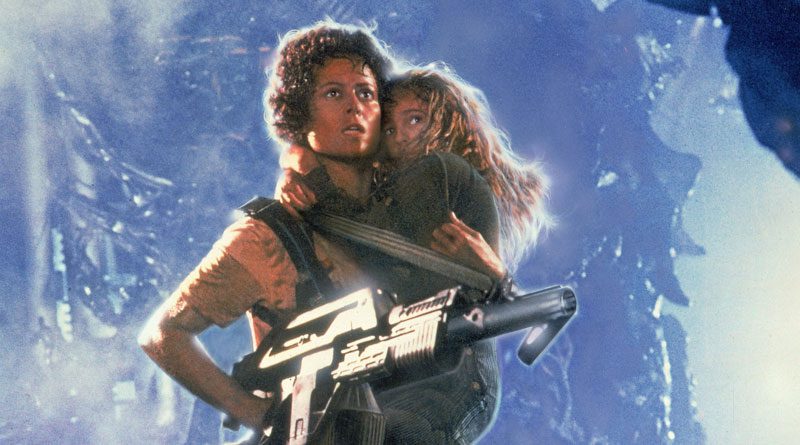Aliens at 35: How the Sequel Still Prevails Until Today
(Disclaimer: This feature article contains spoilers)
James Cameron’s Aliens may have been 35 years ago this weekend. But the 1986 sci-fi action/horror hybrid remains among the quintessential examples of how a great sequel should be.
Rather than repeating the same deliberate and atmospheric slow-burn approach seen in Ridley Scott’s Alien (1979), Cameron took a different path while still maintaining the ominous feel and tone of an Alien movie. That path in question was incorporating war and action genres. He even reintroduced Sigourney Weaver’s Ellen Ripley, who was a survivor from the first film and turned her into an unlikely female action hero in Aliens. And it worked very well because it felt like a natural progression of how a character changes or evolves between the past and present.
Cameron would later adopt the same approach with Linda Hamilton’s role of Sarah Connor, who progresses from a damsel-in-distress in The Terminator (1984) to a battle-ready fighter in Terminator 2: Judgment Day (1991). Of course, it also helps that Sigourney Weaver manages to pull off her role convincingly enough — a result that earned her a well-deserved Oscar nomination for Best Actress. Although she lost to Marlee Matlin for Children of a Lesser God, it remains both an achievement (it was one of Weaver’s best performances in her career) and a rarity. The latter is particularly evident since the Academy is traditionally biased against genre films.
I remember when I first saw Aliens on TV during the 90s and got confused over this and Ridley Scott’s Alien since both films didn’t use the traditional numbers or Roman numerals (as in Alien 2 or Alien II). Speaking of numbers, there was a 2014 news article from Rolling Stone about how Cameron pitched the title to 20th Century Fox by simply adding an “S” on a whiteboard in the room and even added the dollar sign, where it became “Alien$“. The studio ended up using the title Aliens instead of the conventional Alien 2 or Alien II.
There was also another trivia about how Cameron was first approached by the studio to write a treatment for the Alien sequel, thanks to his first Terminator script. Back then, The Terminator was still in pre-production and Cameron came up with the outline for the sequel. However, the studio execs weren’t really pleased over his idea until Cameron wrote a 90-page screenplay during the time when The Terminator was forced to delay for nine months due to Schwarzenegger’s commitment to film Conan the Destroyer. The studio’s bigwigs loved what they read on Cameron’s then-partial screenplay and subsequently agreed to let him continue to write and direct the sequel after Cameron wrapped up with The Terminator.
Released during the 1986 summer-movie season, Aliens shot straight to No. 1 with US$10.0 million during the first 3-day opening weekend in the US box office. It stayed on the top spot for the next 3 weeks, beating newcomers like the Meryl Streep and Jack Nicholson-starred Heartburn, Friday the 13th Part VI: Jason Lives and Howard the Duck. It only took David Cronenberg’s The Fly to finally dethrone Aliens and by then, the sequel was already a financial success before ended its theatrical run after 23 weeks with a respectable US$85.1 million in the stateside alone.
I recently rewatched Aliens on Netflix and no matter how many times I revisited the sequel, I still enjoyed it like I did the first time around. It has the rewatchability value that not even Ridley Scott’s 1979 sci-fi masterpiece could overcome the sequel (at least in my opinion). There are few reasons here, beginning with the pacing of the film. Despite running at nearly 140 minutes (the theatrical cut), the film hardly feels neither heavy-handed nor overstays its welcome. Cameron doesn’t rush the sequel just to get to the point (battling the alien species a.k.a. Xenomorph, that is). He actually takes considerable time to flesh out his story from the beginning as we learn Ripley is rescued by a space crew and subsequently wakes up from hypersleep after 57 years since the event of the first film. Here, Cameron made good use of silence during the quieter moments and only utilises James Horner’s riveting score sparingly, which can be evidently seen during the earlier nightmare sequence.
The first hour of the film is mostly devoted to Ripley’s recuperating period as well as her subsequent involvement as an advisor to help Weyland-Yutani Corporation representative, Carter Burke (Carter Burke) in a rescue mission in the now-inhabited colony of LV-426.
The film also introduced a team of Marines led by the high-ranking but inexperienced Lt. Gorman (William Hope). Each soldier is given their own distinctive personality, namely Michael Biehn’s no-nonsense portrayal as Corporal Hicks and Al Matthews’ cigar-chomping Sergeant Apone. The latter reminds me of R. Lee Ermey’s iconic portrayal as Gunnery Sergeant Hartman in Full Metal Jacket (1987), where both of them happen to share some of the same stern and foul-mouthed personalities.
Then, there’s Bill Paxton as a serial complainer, Private Hudson and even get to say one of the most quotable lines in Aliens (“That’s it, man. Game over, man. Game over!”). Let’s not forget about Jenette Goldstein’s tough portrayal as the bandana-wearing Private Vasquez either, where her iconic appearance became the recent source of inspiration for Samantha Win’s role of Chambers in Zack Snyder’s Army of the Dead.
Even when the film gradually shifted its focus on the LV-426 planet setting, Cameron keeps things steady by building up the suspense and tension as the Marines investigate the surrounding area. It only takes around an hour before we finally see the Xenomorphs sneakily attack the Marines. From there, the action starts to pick up and so do James Horner’s score.
The pace becomes relentless and while Cameron did slow down to make way for another character moment, notably the introduction of a little sole survivor played Carrie Henn as Newt, he regains its momentum for the remainder of the film. On a side note, here’s an interesting trivia about Henn: This may have been her first and only feature-length appearance and yet, she received second billing in the cast (you could see this during the end credits).
As proven in The Terminator, Cameron knows how to stage one propulsive action sequence after another and the film’s bigger budget benefits him in this area. The special effects are top-notch and remain so even today, with the exception of the obviously dated ones seen during the spaceship sequence. But I still love how they did the scene where Bishop (Lance Henriksen) gets violently ripped off in half by the alien queen.
The final third act is another defining moment in the sequel, where Ripley ultimately becomes the last man woman standing as she destroys the alien eggs with a flamethrower and later, single-handedly fights the alien queen using the exoskeleton cargo loader a.k.a. the Power Loader.
The enduring success of Aliens has led countless other like-minded sci-fi films that followed the same pattern and frankly, none of them can outdo what James Cameron has successfully achieved in this sequel. And that even includes Ridley Scott himself, who seems to be rehashing some of Cameron’s storytelling and technical beats of Aliens and incorporated them in his own Alien: Covenant (2017).




